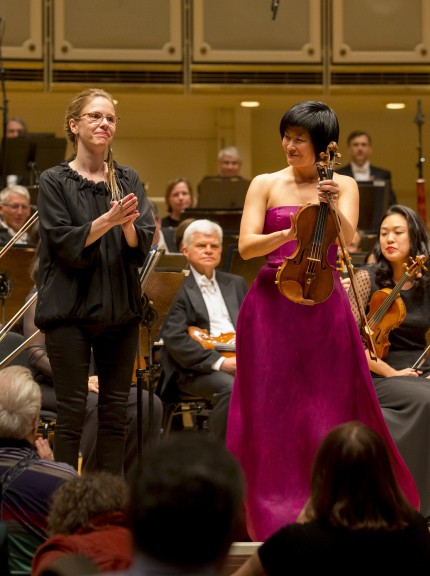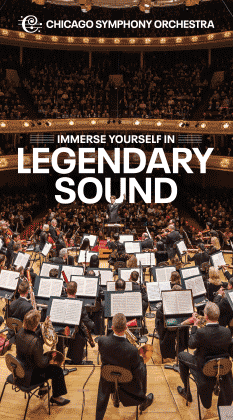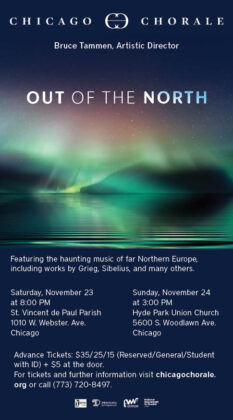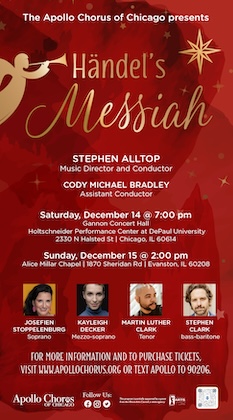Clyne’s “Seamstress” could use more stitchwork in mixed CSO premiere

Contemporary music has not exactly been a hallmark of the Riccardo Muti era at the Chicago Symphony Orchestra, apart from works by the orchestra’s composers in residence.
For their final CSO commissions, Anna Clyne and Mason Bates will each be represented with premieres in this season’s closing weeks. Clyne’s The Seamstress was heard in its world premiere Thursday night, performed by violinist Jennifer Koh with Ludovic Morlot leading the orchestra.
A violin concerto in all but name, The Seamstress takes its title from a William Butler Yeats poem. Clyne posits the work as “an imaginary one-act ballet,” her fanciful scenario painting the title woman seated alone on stage, unraveling threads from a cloth. As she works, the mind of the seamstress (a stand-in for the composer?) wanders and her imagination is reflected in “five tales that range from love to despair, and that combine memory with fantasy.”
Though Clyne’s score appends Yeats’ stanzas to the various sections, the music is cast in one unbroken 25-minute movement. The Seamstress is launched with a folk-like theme played by the solo violinist that has a clear Irish flavor, reflecting the poem’s author.
The restless orchestra fitfully erupts into roiling, sea-tossed bursts with passages of breakout virtuosity for the violinist. But the predominant mood of The Seamstress is one of reflective melancholy, which is as sensitively conveyed by Koh as is the soloist’s fire in the bravura moments.
Clyne has shown herself a quick study at writing for larger forces in her previous CSO commission Night Ferry, premiered in 2012. Here too, her scoring is impressive, with subtle undulating wind and string textures that support and expand on the soloist’s musing, introspective lines.
The Seamstress has two unavoidable issues—one is a coda that feels rather anticlimactic as if the composer has simply run out of things to say.
The other is its ill-judged electronic component. Clyne has added loops of Yeats’ lines, read by her Irish colleague Irene Buckley, along with whispers and breathy sounds. The words are largely inaudible and indecipherable in the manipulated electronic sampling until the end of the piece.
The problem is the failure to successfully incorporate the sampling with the live music. The initial entrance of Buckley’s warmup exercises crashes in so jarringly that it makes an almost comic effect, taking one completely out of what had been a compelling musical argument by Koh and the orchestra. The ensuing Lamaze Method sounds are just as bizarre and intrusive.
The Seamstress has some lovely moments and is an engaging work in Clyne’s best affecting vein. As with many of the composer’s efforts, The Seamstress would seem to be a much stronger and more effective piece in an unplugged version minus the electronics, which feel unnecessary and grafted on. Perhaps future revisions will show this appealing music in a more consistently positive light.
Certainly, Clyne’s concerto could not have wanted for finer solo advocacy. Koh, who also performed Clyne’s Prince of Clouds with Jaime Laredo and the CSO, was a superbly committed soloist, incisive in the dramatic passages, and drawing out the lyrical introspection.
For a much-publicized world premiere there were very few principal players on hand. Even so, Morlot drew refined and tight, responsive support, apart from the flutes and piccolo, whose edgy, sharp tones were a repeated drag on the performance.
The evening led off with Berlioz’s Les francs-juges Overture. At 13 minutes, the longest of the French composer’s rambunctious overtures can feel long-winded, but Morlot paced it with great skill. If the music’s wry wit didn’t always come across, Morlot elicited a shining, spirited performance, with notably sonorous brass in the spacious introduction.
Beethoven’s epic Symphony No. 3 concluded the evening. As with most younger conductors, Morlot’s Beethoven has clearly imbibed the influence of the period-instrument brigades, and his “Eroica” went with quick tempos, taut rhythms and lean vibrato. Yet, for all its bracing vigor, at times one wanted a touch more idiosyncrasy amid the streamlined momentum.
Still, this was by any measure strongly projected and tautly dramatic Beethoven. Undistracted by the rude unmuffled coughs, Morlot and the orchestra conjured a flowing and eloquent funeral march, subtle in expression yet building to an imposing climax. The Scherzo was suitably energetic with wonderfully raucous horns, and the performance was rounded off with a vividly characterized set of variations and blazing coda.
A section horn burble in the opening minutes apart, the orchestra played with highly polished dedication and combustible elan throughout.
The program will be repeated 8 p.m. Saturday and 6:30 p.m. Tuesday (minus the Berlioz). cso.org; 312-294-3000.
Posted in Uncategorized





Posted May 31, 2015 at 6:03 am by Roland Buck
I attended the Saturday concert and heard a great masterwork that will still be performed 200 years from now. Unfortunately the masterwork was Beethoven’s Third Symphony and not Cline’s effort. Cline’s entry was another example of the kind of mediocre and unimpressive works most modern classical composers are producing now that they have liberated themselves from atonality and serialism, which had caused them to produce absolutely awful works. The abandonment of atonality and serialism and the return to tonality by modern composers has been a big improvement. But now they are at a loss of what to do in order to produce original works, rather than rehash 19th century music, and, as a result, are floundering. The results so far have not, on the whole, been impressive. The composer who finds a solution to this and points the way forward will be the greatest composer of the 21st century, but so far he/she has not shown up.
Posted May 16, 2016 at 6:52 pm by Bill Alpert
Not to be disagreeable, but…
I attended a 2015 performance of “Seamstress” with Koh and Orpheus on tour in California. IMHO this new violin concerto was nothing less than riveting, a beautiful new work for violin which deserves to be performed and recorded for wider audiences! I was transfixed for the entire 20 minutes, both by Koh’s virtuosity and the ever changing aural canvas the work creates.